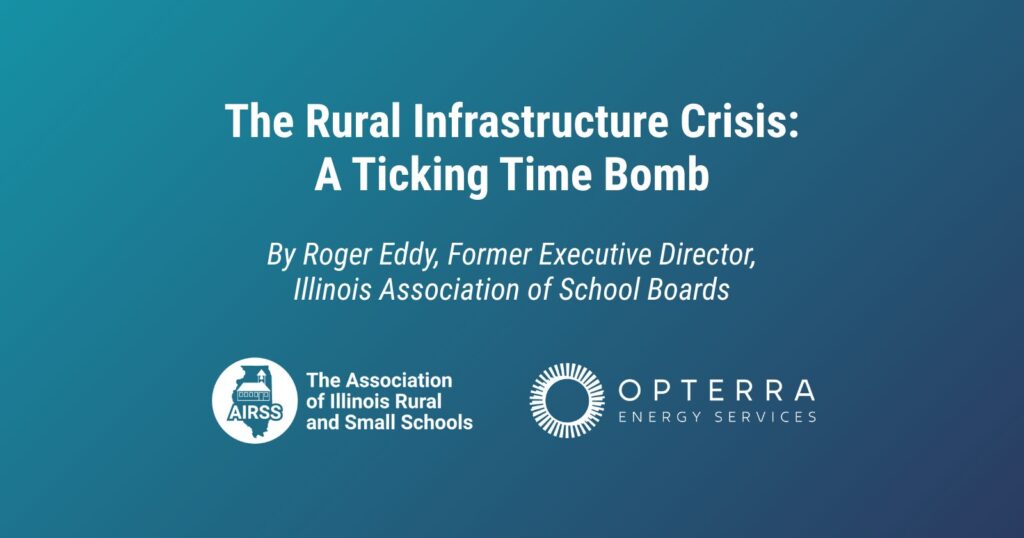By Roger Eddy, Former Executive Director, Illinois Association of School Boards
This article is part two of a series by AIRSS and OPTERRA Energy Services to explore the coming crisis of rural school infrastructure. Traditional, piecemeal solutions are no longer sufficient to address this issue, and rural schools must move beyond traditional vendor relationships to strategic trusted partnerships. This series provides immediate solutions to this crisis. In the present article, Roger Eddy explores the coming crisis in more detail, and underscores the necessity for new approaches to the challenge.
Having worked with hundreds of school boards throughout Illinois during my time as the executive Director of IASB, I have seen firsthand how a mentality of “kicking the can down the road” has created an unprecedented infrastructure crisis in rural school facilities. This is a perfect storm of deferred decisions, escalating costs, and scarce resources that directly threaten the foundation of rural education in America.
The numbers paint a sobering picture purely based on facts. Many rural school buildings were constructed 50-100 years ago and desperately need comprehensive modernization to meet current health, safety, and educational standards. Despite this obvious need, the National Center for Education Statistics reports that rural districts spend significantly less per student on capital outlay than their urban counterparts. This creates a widening gap in facility quality and educational opportunity.
One of the main reasons rural districts struggle with this crisis is their limited administrative capacity and lack of specialized expertise. Unlike larger urban school systems with dedicated facilities departments and professional project managers, rural districts typically operate with smaller administrative teams where staff members are forced to wear multiple hats. A single superintendent may be responsible for overseeing curriculum, personnel, community relations, and facilities management all at once. Furthermore, school board members are community volunteers with full-time careers in agriculture or local businesses. While some of these public servants have some background or experience in maintenance related issues, These volunteers often lack the technical knowledge needed to evaluate complex infrastructure proposals or navigate the complicated world of construction contracts and compliance requirements. This lack of expertise and administrative capacity along with funding issues is a are core reasons that rural districts tend to defer these critical decisions, leading to a looming infrastructure risk.
The “deferring decisions” mindset, while understandable based on the lack of funding and expertise, has a compounding effect. The longer a district waits, the more expensive a project becomes. With current construction cost inflation averaging 6.6% annually in the U.S., a project that would have cost $1,000,000 five years ago now requires an investment of over $1,400,000. This is a serious problem because when infrastructure failures become emergencies—like a collapsing roof, a failing heating system, or a code violation that forces a closure—the costs have already escalated dramatically. Emergency procurement also eliminates the benefits of holistic long-term planning, forcing districts into reactive and often more expensive decisions.
The regulatory environment further complicates things for rural districts. Modern school construction must comply with dozens of federal, state, and local requirements related to environmental standards, accessibility, building codes, and safety. Urban districts can manage these complexities with dedicated staff and consultants, but rural districts often find themselves overwhelmed without that specialized legal and technical support often available in larger districts.
The long-term impact on educational equity is the most troubling aspect of this crisis. Students in schools with failing infrastructure face learning environments that cannot support modern technology, provide appropriate modernized space to address special education needs, or collaborative learning spaces. Inadequate ventilation in science labs, leaking roofs in gymnasiums, and unreliable heating and cooling in classrooms create educational disadvantages that compound over time. These facility deficiencies directly impact student outcomes, teacher recruitment and retention, and community pride.
This crisis also has significant economic implications for rural communities, which often view their schools as economic anchors and a source of identity. Deteriorating school facilities can signal community decline and accelerate population loss, business relocations, and property value depreciation. In many rural communities, the school is the de facto center of the community. Conversely, modernized educational facilities can be catalysts for economic development and revitalization.
Traditional solutions, such as low-bid procurement and one-time vendor relationships, have proven insufficient for the complexity and scale of rural infrastructure needs33. Rural districts need experienced partners who understand their unique challenges, the regulatory environment, and community dynamics. They need relationships that go beyond a single project and include long-term facility stewardship, ongoing maintenance support, and strategic planning capabilities. The evidence suggests that rural districts must move away from simple vendor relationships and toward true partnerships. The question is not whether they can afford to invest in these partnerships, but whether they can afford not to.
In September, the AIRSS, representing more than 500 member districts, announced its Premier Annual Sponsorship with OPTERRA – Partnering to Power Progress Across Rural and Small Schools. This partnership is designed to bring unprecedented support to rural and small schools by addressing critical infrastructure and facilities needs while reducing financial and operational barriers for school leaders. For more information, please visit the Resources for Facilities and Infrastructure Renewal.
About the Author:
Roger Eddy brings over four decades of experience as an educator and administrator at all levels from PreK to Community College. In addition to being a rural educator, Eddy served five terms in the Illinois House of Representatives and was Executive Director of the Illinois Association of School Boards.

